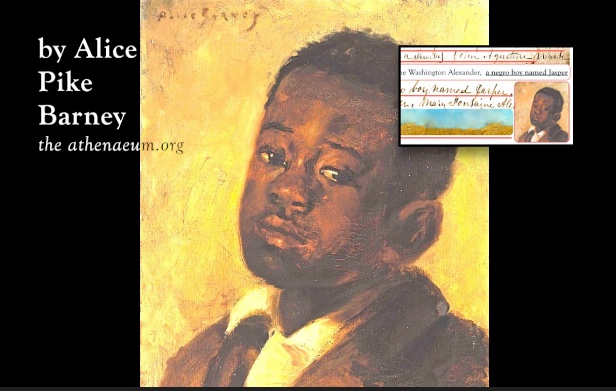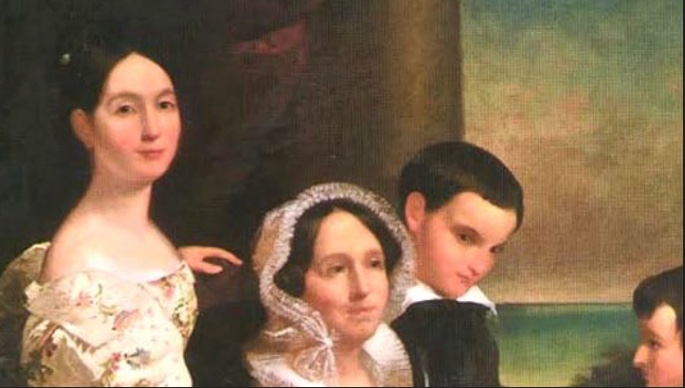1857 words
STORY 10 – JASPER THOMPSON BEGINS LIFE https://www.youtube.com/watch?v=4LJpJeIwFMw#t=28m47s
With support from American Public University System (apus.edu). The sentiments expressed do not in any way reflect modern-day policies of APUS, and are intended to encourage fact-based exchange for a better understanding of our nation’s foundational values.
FLICKR 29 images
https://www.flickr.com/photos/jimsurkamp/albums/72157685472796192
CLICK HERE. This will take you to the beginning of this video within the much longer video – START: 28:47 https://www.youtube.com/watch?v=4LJpJeIwFMw#t=28m47s
PRECEDED BY: Intermission VIDEO START: 27:28
https://www.youtube.com/watch?v=4LJpJeIwFMw#t=27m28s


In January, 1844 Jasper Thompson was born to Solomon Thompson and Eliza Gray Thompson.

https://www.wikiart.org/en/albrecht-durer/head-of-an-african; Thompson Family Collection, Kansas Collection, RH MS 510, Kenneth Spencer Research Library, University of Kansas Libraries – etext.ku.edu ; Monique Crippen Hopkins at genealogybreakingdownthewalls.blogspot.com

The family’s written records show Eliza was the daughter of Harry Gray and Phanny (Fanny) Mitchell.

Jasper was born at a location that Jasper himself simply called, in his official enlistment form for the United States Colored Troops later on – as “Harper’s Ferry.”


West Virginia and Regional History Collection




Researching the lives of the enslaved is hard – because only first names are in most records and no courthouse death records in Jefferson County existed there for before 1853.


JCBW Will Book 14 Page 342 9/17/1855 (Search “Jane C. Washington”) – ancestry.com ; detail from “Mrs. J.A.W.” by John Gadsby Chapman – donated by Anne and Patty Washington to the George Washington Masonic Memorial Association. – archives.mountvernon.org ; detail from The Veteran in a New Field by Winslow Homer – 1865 metmuseum.org ; Head of a Negro Boy by Alice Pike Barney – Date unknown
Smithsonian American Art Museum americanart.si.edu

But Jasper Thompson may have well been the (quote) negro boy named Jasper (end quote) that Jane Charlotte Washington, then the owner of Mount Vernon, cited in her will and gave, in the parlance of the time, to the son of her prematurely deceased eldest daughter, Anna Maria Tomasina Alexander.

Anna Maria had married Doctor William F. Alexander and they began making house and making farm.

Creator(s): Historic American Buildings Survey, creator
Date Created/Published: Documentation compiled after 1933
loc.gov
The couple began making house, renting a small structure from John Humphreys just east of Charles Town off the Harper’s Ferry Road, called Walnut Hill.



References:
1. Jasper Thompson USCT 23rd infantry regiment service record,p. 18
fold3.com 16 September 2011 Web. 20 October 2016.
2. Video of Monique Crippen Hopkins – April, 2016 – Perry Room, Charles Town Library, Charles Town, West Virginia
3. Jefferson County Clerk Deed Room, Charles Town, WV.
ID 57780 Washington, Jane C. 9/17/1855
Jefferson County, WV, Will Book 14 Pages 341-345
Jefferson County VA/WV Index to Wills, Vol. 1, 1801 – 1970
Page 341, View Pages 342-343, View Pages 344-345
4. Allen, John C. (2011). “Uncommon Vernacular: The Early Houses of Jefferson County, West Virginia 1735-1835.” Morgantown, WV: West Virginia University Press. pp. 228 & 324.
5. John C. Allen email – January 5, 2016. (Mr. Allen is the author of “Uncommon Vernacular,” a book on structures in Jefferson County, Va. prior to the advent of the railroad).
On Tue, Jan 5, 2016 at 6:07 PM, John Allen wrote:
Jim,
My estimate of the construction date of the main part of Walnut Hill is ca. 1845. This main block is the front section shown in the HABS photo in my book (pg. 324). Here’s why I called it the Humphreys-Alexander House:
In 1820, the property’s owner, Thomas Wilson, was assessed as having $100 in buildings. That’s a very modest building, probably a one- or two-room cabin. In 1825 when the property passed to John Humphreys the assessment was $110 – no change, just inflation.
In 1827 the assessment rose to $1000 for “new wing on old house.” That new wing is the back wing of the current house. it was not a house, just a wing. Two years later his assessment rose by $300 for “new stone kitchen”. This is the back addition to the aforementioned wing. There is a clear photo of these two sections in the second HABS photo of the building (at Library of Congress website, not in my book). Still, these were service wings to a main house.
In 1839, the property was sold to W.F. Alexander. In 1841, Alexander’s building assessment dropped from $1,410 to $1,200. This drop reflects the demolition of the original house, while the newer wing and it’s kitchen addition remained. In 1850 Alexander’s assessment rose to $2,000 showing that the front section (again pictured in the book) had been completed. This main section of the house is a very substantial, stone central-hall house with very nice interior detailing of that 1850 period. So, that’s my take on the house. The back is Humphreys and the front is Alexander.


CHAPTER OR STORY 11 – CLICK HERE https://civilwarscholars.com/uncategorized/chapter-11-ones-work-in-1850-by-jim-surkamp/
